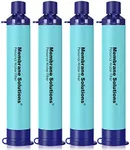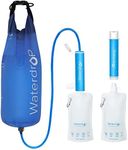Buying Guide for the Best Portable Water Purifiers
Choosing the right portable water purifier is essential for ensuring you have access to clean and safe drinking water, especially when you're on the go, camping, hiking, or traveling. The right purifier will depend on your specific needs, such as the type of contaminants you need to remove, the volume of water you need to purify, and how portable you need the device to be. Here are some key specifications to consider when selecting a portable water purifier and how to navigate them to find the best fit for you.Filtration MethodThe filtration method determines how the purifier removes contaminants from the water. Common methods include activated carbon filters, ceramic filters, UV light, and reverse osmosis. Activated carbon filters are great for removing chlorine, bad tastes, and odors, while ceramic filters can remove bacteria and protozoa. UV light purifiers are effective against bacteria and viruses but require batteries. Reverse osmosis systems are the most comprehensive, removing a wide range of contaminants, but they are bulkier. Choose a method based on the contaminants you expect to encounter and the level of portability you need.
Filter LifespanFilter lifespan indicates how long the filter will last before it needs to be replaced. This is usually measured in liters or gallons of water filtered. A longer lifespan means less frequent replacements, which can be more convenient and cost-effective. If you plan to use the purifier frequently or for extended trips, look for a filter with a longer lifespan. For occasional use, a shorter lifespan may be sufficient.
Flow RateFlow rate refers to how quickly the purifier can process water, usually measured in liters per minute. A higher flow rate means you can get clean water faster, which is important if you need to purify large amounts of water or if you're in a hurry. However, higher flow rates can sometimes mean less thorough filtration. Consider your typical water needs and balance the flow rate with the level of filtration required.
Weight and SizeWeight and size are crucial for portability. If you're backpacking or hiking, you'll want a lightweight and compact purifier that won't take up much space in your pack. For car camping or less mobile activities, a larger and heavier purifier might be acceptable. Assess how much space and weight you can afford to dedicate to your water purifier based on your typical activities.
Ease of UseEase of use includes how simple the purifier is to set up, operate, and maintain. Some purifiers require pumping, which can be labor-intensive, while others use gravity or are battery-operated. Consider how much effort you're willing to put into using the purifier. Additionally, check how easy it is to clean and replace filters, as this will affect long-term usability.
Contaminant RemovalDifferent purifiers are designed to remove different types of contaminants, such as bacteria, viruses, protozoa, chemicals, and heavy metals. It's important to know what contaminants are common in the areas you'll be using the purifier. For example, if you're traveling in areas with known waterborne viruses, you'll need a purifier that can handle viruses. Match the purifier's capabilities with the specific contaminants you need to address.
DurabilityDurability refers to how well the purifier can withstand rough handling and harsh conditions. If you plan to use the purifier in rugged environments, look for one made from durable materials that can handle drops, impacts, and exposure to the elements. A more durable purifier will last longer and provide reliable performance in challenging conditions.























